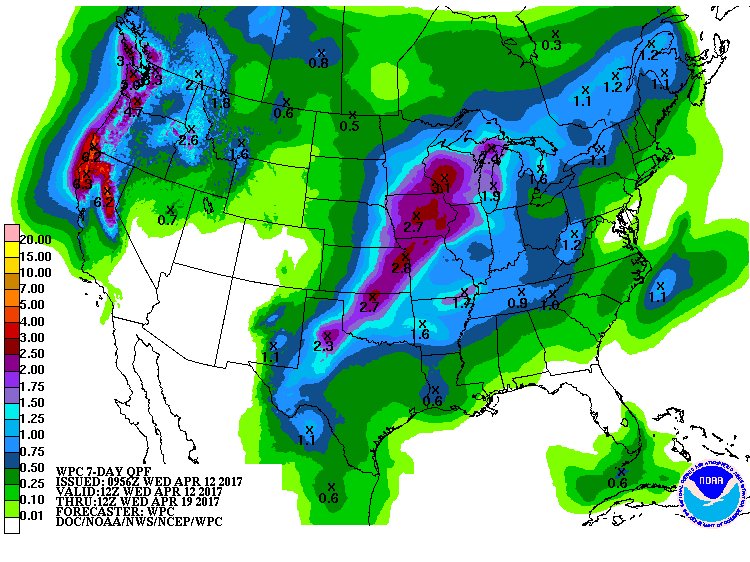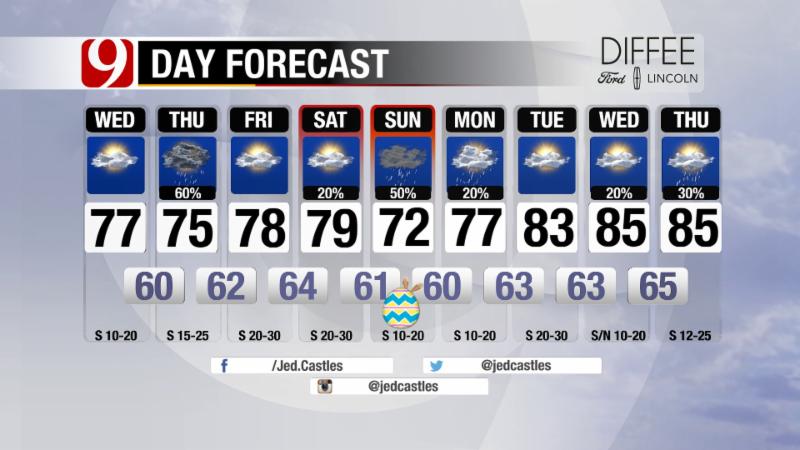 |
We invite you to listen to us on great radio stations across the region on the Radio Oklahoma Network weekdays- if you missed this morning's Farm News - or you are in an area where you can't hear it- click here for this morning's Farm news from Ron Hays on RON.
Let's Check the Markets!
FedCattleExchange.com has a total of 5,245 cattle on their showlist for the today's sale of finished cattle-the sale starts at 10 AM this morning- click here for more details.
Today's First Look:
mornings with cash and futures reviewed- includes where the Cash Cattle market stands, the latest Feeder Cattle Markets Etc.
Each afternoon we are posting a recap of that day's markets as analyzed by Justin Lewis of KIS futures- click or tap here for the report posted yesterday afternoon around 3:30 PM.
Okla Cash Grain:
Futures Wrap:
Feeder Cattle Recap:
Slaughter Cattle Recap:
TCFA Feedlot Recap:
Our Oklahoma Farm Report Team!!!!
Ron Hays, Senior Farm Director and Editor
Carson Horn, Associate Farm Director and Editor
Pam Arterburn, Calendar and Template Manager
Dave Lanning, Markets and Production
|
|
Oklahoma's Latest Farm and Ranch News
Your Update from Ron Hays of RON
Wednesday, April 12, 2017
|
Howdy Neighbors!
Here is your daily Oklahoma farm and ranch news update.
|
|
|
Featured Story:
 Livestock Industry Applauds Trump's Decision to Delay GIPSA Rules- AFBF Still Wants Poultry Regs Livestock Industry Applauds Trump's Decision to Delay GIPSA Rules- AFBF Still Wants Poultry Regs
The Trump administration yesterday gave notice that it will further delay the effective date of a regulation related to the buying and selling of livestock, a move applauded by members of the livestock industry, particularly beef and pork producers, which oppose the Obama-era rule. The administration will accept comments from the public on what to do with the regulation.
The so-called Farmer Fair Practices Rules, written by the U.S. Department of Agriculture's Grain Inspection, Packers and Stockyards Administration (GIPSA), includes two proposed regulations and an interim final rule, the latter of which being the most concerning to livestock producers and now, is set to become effective Oct. 19.
"We're extremely pleased that the Trump administration has extended the time it has to review this regulation and the public comments on it, which will show the devastating effects this rule would have on America's pork producers," said NPPC President Ken Maschhoff, a pork producer from Carlyle, Ill. "The regulation likely would restrict the buying and selling of livestock, lead to consolidation of the livestock industry - putting farmers out of business - and increase consumer prices for meat."
Click here to read the full reaction from the NPPC.
Cattlemen across the country are also cheering, wiping nervous sweat from their brows as news of postponement broke yesterday.
"This is another step toward common sense and away from counterproductive government intrusion in the free market," said NCBA President Craig Uden. "That said, while a delay is welcome, ultimately this rule should be killed and American cattle producers should be free to market our beef without the threat of government-sanctioned frivolous lawsuits."
Click here for NCBA's full statement regarding the GIPSA Rule delay. Finally- the American Farm Bureau weighed in with a mixed review on the Trump Administration's move on GIPSA. AFBF President Zippy Duvall offered this one paragraph on what the general farm group is thinking on GIPSA- "We support preserving the contract and marketing arrangements that are working for the beef and pork sectors, and we will reinforce that point during the comment period. There is still vast room for improvement, however, in efforts to ensure a level playing field for poultry farmers. We will continue to emphasize the need to seek additional safeguards in the poultry sector to better protect individual farmers from discriminatory treatment, without disrupting the business practices that are working in the beef and pork sectors."
|
|
Sponsor Spotlight
P&K Equipment is Oklahoma's premier John Deere dealership. Whether it's residential, commercial, construction, or agricultural equipment, they've got it all- the inventory AND the resources to keep it running strong. Alongside the long-lasting John Deere brand, P&K shares a commitment to providing cutting edge solutions. P&K has ten locations in Oklahoma and nine in eastern Iowa; their mission is to create business relationships through honesty, courtesy, and a sense of urgency. They'll put their network, resources, and solutions to work for YOU. Visit P&K Equipment online... meet the experts and find out just why in Oklahoma John Deere starts with P&K.
|
|
Yesterday, I caught up with Oklahoma State University State Wheat Breeder Dr. Brett Carver, who presented to the Oklahoma Wheat Commission on the most recent work being conducted by his team, particularly about the great success had by the program lately, in being able to meet the needs of farmers in the state and across the Southern Plains where growers utilize wheat for graze and grain. According to a recent report listing the top varieties planted in Oklahoma, varieties from Dr. Carver's program occupied the top six placements on the list.
"I'm just tickled to death to see that," he responded. "We decided long ago that we couldn't just breed the varieties like we always have and test them for that ability to be adopted to this, the dual-purpose system. It's engrained into the breeding system. It's part of our heritage. It's part of our philosophy and it's here to stay."
In demonstration of that mission, Carver and his team have an extensive amount of testing underway for the next generation of wheat varieties, with 13 different experimental varietals currently plotted and under evaluation. In fact, you can find out more on these varieities being tested, by attending an upcoming wheat plot tour. Click here to check out all the dates and locations of these events being hosted by OSU, on our website's calendar of events. "That doesn't reflect the inability to make a decision," Carver joked. "It does reflect a very big pipeline... All those lines have merit in way or another."
Read more about what's coming down the pipeline in Dr. Carver's wheat breeding program, or hear him talk about it himself, by listening to my interview with him. Click here to tune in. |
|
USDA released its April 2017 World Agricultural Supply and Demand Estimates report yesterday. Here are some key highlights from this report.
Regarding wheat, US ending stocks for 2016/17 have been raised 30 million bushels based on lower feed and residual use. This more than offset a slight reduction of imports. Ending stocks are projected to reach a near 30-year high, at 1,159 million bushels. Global supply estimates are raised by 1.7 million tons, and total global consumption is lowered 0.6 million tons to 740.8 million.
Ending stocks estimates for corn were unchanged, with an increase in corn to produce ethanol offsetting reduced feed and residual use. Ethanol production was above expectations in March, but there was a 50 million bushel reduction in projected feed and residual use.
Highlights on soybeans include higher seed use, reduced residual disappearance and higher ending stocks. Exports and crush estimates are unchanged, leaving soybean ending stocks projected at 445 million bushels, 10 million higher than last month.
|
 Begin With the End In Mind - Finding the Right EPD Mix in Your Herd to Improve Quality and Profit Begin With the End In Mind - Finding the Right EPD Mix in Your Herd to Improve Quality and Profit
The process of selecting the right mix of EPDs in your herd in order to get the most bang for your buck is something of an art. Dr. Ty Lawrence of West Texas A&M told me recently that when it comes to making your genetic selections, you should try to strike a good balance of traits that are economically important for your bottom line, like tenderness for instance. "If you're really going to improve tenderness per se, there are methods to do that," Lawrence insisted. "You're going to have to look at the individual situation and the individual animals and make a decision as to whether that's good for your herd." One management practice to improve the quality of the end product, is as simple as paying attention to the overall health of your animals. Lawrence says for example, a sick cow versus a healthy cow will inevitably have a lighter carcass weight and a tougher eating experience for the consumer. "Health management is something that all producers can do regardless of the segment to improve the eating satisfaction of our product," he said. "I think the key is to always begin with the end in mind." Listen to Lawrence and I discuss easy to manage methods producers can practice that will improve their product quality and their bottom lines, on yesterday's Beef Buzz - click here. |
|
Sponsor Spotlight
Midwest Farm Shows is proud to produce the two best Farm Shows in the State of Oklahoma annually- the Tulsa Farm Show each December and the Oklahoma City Farm Show each April.
Make Plans to attend the Oklahoma City Farm Show, coming April 20, 21 and 22, 2017. Admission and Parking are free.
Exhibits include all of the latest in agriculture with a full line of displays, including tractor, sprayer, tillage, harvest equipment, cattle management products, and more. In addition to indoor and outdoor exhibits, daily horse training seminars, cattle chute demonstrations, cattle grading competitions, and prize drawings make the Oklahoma City Farm Show a don't-miss event.
Click here for more details about the 2017 Oklahoma City Farm Show- presented by Midwest Farm Shows.
|
|
The Noble Foundation recently released an article outlining the value of implementing an artificial insemination program on your operation, written with a very conceptual perspective. The author of that article expanded upon that laid "groundwork" by compiling a list of priorities a producer thinking about adding AI as a breeding option on their farm should consider.
1. Predetermine outcomes prior to implementation based upon listed goals and objectives
Setting goals isn't fun, but it is necessary, especially as we determine the value in branching into something new. These goals need to include optimizing soil and forage resources exhibited at the ranch level, minimizing costs of production, and maximizing marketing opportunities.
2. Determine limitations to implementation
Inadequate facilities and inaccessibility to qualified labor are very real obstacles. Keep in mind that an AI program will get you closer to your cattle, but you don't want them too close. Therefore, adequate facilities and access to labor (quality and quantity) are extremely important.
3. Differentiate the AI from the bull-bred calves Although benefits of a typical commercial AI program include less bull dependency and synchronized heat cycles (assuming timed breeding), utilize this effort as an opportunity to meet additional objectives by selecting the AI sire on different/additional criteria than cleanup bulls. Check out the rest of Noble's tips on implementing an AI program on your operation, by visiting the original article - click here.
|
|
Want to Have the Latest Energy News Delivered to Your Inbox Daily?

Award winning broadcast journalist Jerry Bohnen has spent years learning and understanding how to cover the energy business here in the southern plains- Click here to subscribe to his daily update of top Energy News.
|
|
Continuing this week's salute to the District Stars in Agriscience, we highlight today, Abby Parrish of the Oologah FFA Chapter representing the Northeast District. The findings from Parrish's experiments with soil types have proven to be of practical use for those who might have construction projects in the works on the farm.
"What I was working on is finding out which soil is the best to use to retain moisture where it's not going to make your foundation crack under weight loads," she explained. "The actual experiment was going out and finding three different types of soils that are readily used in Northeast Oklahoma by contractors and taking those to a testing company, adding in the moisture and finding out which one is compacting right that won't fall apart when you are using it."
In the end, Parrish discovered sandy loam soil works the best when laying ground work for the foundation of a building and will hold up the heaviest loads. Parrish says this information can come in handy for those considering any construction projects on the homestead.
"It's awesome to use for whether you're a contractor in the field, whether you're just a farmer building on your farm or if you're wanting to build a house - you can this this information that I came up with," Parrish offered.
You can read more about Parrish and her experiences as a member of the FFA, or listen to my interview with her, by clicking here.
American Farmers & Ranchers is the proud sponsor of our District Star spotlights this month. Be sure to visit the AFR website by clicking or tapping here
to learn more on how AFR supports the young people of Oklahoma, and how AFR can provide you with quality insurance for your home, auto, farm, and life.
|
 Rainfall Still in the Mix in our Seven and Nine Day Graphics- Take a Look! Rainfall Still in the Mix in our Seven and Nine Day Graphics- Take a Look! The National Weather Service US Map for seven day rainfall shows a pretty good dose of rainfall in much of the wheat and canola areas of Oklahoma- we grabbed it off a Tweet from DTN Meteorologist Bryce Anderson:

Meanwhile, the day by day forecast for central and western Oklahoma, courtesy of Jed Castles from News9, offers some insight as to when we might see rainfall from later today into next week:  Chances seemed to be higher for rainfall for this weekend yesterday morning- but rainfall remains in the mix as you see from both of these graphics.
|
|
Our thanks to Midwest Farms Shows, P & K Equipment, American Farmers & Ranchers, Livestock Exchange at the Oklahoma National Stockyards, OERB, Oklahoma Farm Bureau, Stillwater Milling Company, Oklahoma AgCredit, the Oklahoma Cattlemens Association, and KIS Futures for their support of our daily Farm News Update. For your convenience, we have our sponsors' websites linked here- just click on their name to jump to their website- check their sites out and let these folks know you appreciate the support of this daily email, as their sponsorship helps us keep this arriving in your inbox on a regular basis- at NO Charge!
We also invite you to check out our website at the link below to check out an archive of these daily emails, audio reports and top farm news story links from around the globe.
Click here to check out WWW.OklahomaFarmReport.Com
God Bless! You can reach us at the following:
phone: 405-473-6144
|
|
|